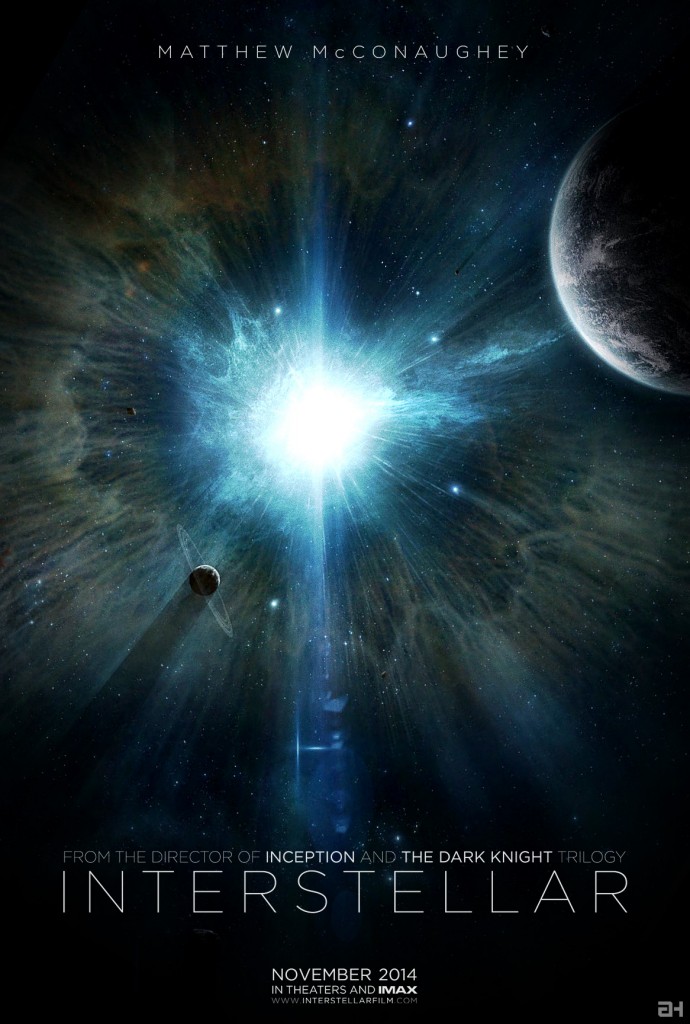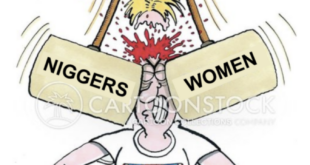Ernest Hall
Council of European Canadians
December 18, 2014

The 2014 blockbuster Interstellar depicts a mid-21st-century USA that has undergone serious decline, in almost all areas, for decades. The USA still hobbles along but has turned into a mushy, faded carbon copy of its former self. Mired in hopelessness, the political apparatus is tasked with managing further decline (which it does in certain pathetic and entertaining ways).
After being shown this vision of our own future, at some point after about the first hour a different movie (in effect) begins. It involves the movie’s titular “interstellar” colonization effort and off we go “through the looking glass” into the wild black yonder of outer space. The rest of the film is only loosely related to the movie we had seen up to that point.
Staying with the USA as depicted in the film’s first hour: What caused such a steep decline? The answer: “Blight” did it. Blight is only offhandedly-alluded-to on screen and is not explained. So what might it mean? Global warming? Not likely (see point 8 below).
It will be shown that “Blight” in Interstellar can be seen as a racial metaphor for the effects of the ethnocultural displacement of the USA’s core White population by immigrants and resultant Third Worldization.
Blight-Induced Decline as Racial-Displacement-Induced Decline

In the universe of Interstellar, social, cultural, and economic decline have all come because of the corrosive effects of “Blight”. “Blight” makes areas unlivable, causes people to emigrate (White Flight), and the spread of Blight, in a few decades’ time, we are told, may spell the end of humanity itself.
Let’s be very clear, again: “Blight” means Nonwhite immigration and Third Worldization. Continuing the metaphor, “humanity” by metaphor is the White Core population of the USA.1
Consider the following:
1. Blight acts slowly, over years and decades. People in Interstellar’s USA may be down on their luck, but they can earn a fair living. They face slow decline. Likewise, real and ongoing racial dispossession is gradual and steady, not a rapid knock-out game. It probably rarely is a rapid process, in any time or place. Racial displacement is generally a process that occurs over decades, even centuries. The USA was nearly 90 percent White as late as the mid-1960s, vs. only 60+ percent White today; only about 50 percent of children in the USA are White.
2. Blight steadily erodes quality of life in one area after another, inducing people to emigrate from their homes: White Flight.
3. The choice of the term “Blight”: In general modern usage in the USA, “blight” refers to urban decay. “Blight” in this sense is an unmistakably racialized term (along these lines is the term “ghetto”, for instance; no American today today would refer to a poor White community as a ghetto). The phrase “urban blight” conjures up images of abandoned buildings; dilapidated houses; bullet holes; crime; and…Nonwhites (especially Blacks). There is an implication that the area was formerly all-White but then was “afflicted by urban blight” (as if it were a virus) and so became mired in hopelessness. Along the way, incidentally, it racially transformed into a Nonwhite enclave. The filmmakers could have chosen any number of words to describe their mysterious phenomenon (which they never bother to define) but chose to use “blight”.
4. Post-Blight society in Interstellar maintains a general disparagement of the accomplishments of the (White) past as a way to cope with the new realities dictated by Blight. The official policy of the post-Blight America is that the Moon landings were faked. Administrators at schools are to mete out disciplinary action to students who spread the conspiracy theory that the USA actually landed men on the Moon. This profoundly angers the main character, Cooper (Matthew McConaughey). He refuses to go along with the lie and confronts the school officials.
We already see a version of this today in the USA. You know, the history of the USA as an evil, unjust, terror state. Just like Hitler invaded a series of countries solely to round up and kill their Jews (the average person vaguely believes), the USA’s raison d’etre from the beginning, many vaguely believe, was to persecute and terrorize saintly Nonwhites of various kinds. The heroic Civil Rights crusaders fought back and triumphed. MLK as Jesus. You know.
This is increasingly becoming the only vision of the arc of U.S. history allowed in respectable society. A profoundly informative survey asked high school students in 2008:
“Who are the greatest heroes in American history?” (excluding presidents)
This seems almost beyond belief, but these are the actual results. This is not satire. These three people, in that order, are the three greatest heroes in all of American history, according to a scientific survey of American high school students a few years ago. Oprah Winfrey also made the top ten.
It’s not teenagers’ fault. They were trained to think that way in school. Still, we ought to be a bit angered by this kind of thing (which is the direct product of school curriculum), just as Cooper in Interstellar is angered by the curriculum teaching the Moon landings were faked. Both — the fake Moon landing idea and the idea of the USA (and all European-founded societies) as inherently evil — serve similar purposes, to lose hope in the future by losing inspiration from the past.
I’ll go so far as to say that the belief that MLK, Rosa Parks, and Harriet Tubman were “the greatest American heroes in history” is profoundly anti-American. Frankly. It is a sign of a serious cultural blight. This is not the realm of conspiracy theory or fantasy or some vague quasi-dystopian future. It’s here. It’s already here. We are culturally blighted without Blight.
5. There is a general decline in cultural output in Blight-affected society. Early in Interstellar, we see a traveling baseball team of apparent amateurs. It is revealed that they are the “New York Yankees”. One of the most tired and cliche of all the diversity buzzwords is “vibrant”. Vibrant is a code word for Nonwhite in our Multicultacracy’s lexicon. As Steve Sailer often points out, though, many Vibrant Americans aren’t particularly “vibrant”. The USA’s now 20 percent Hispanic population is almost completely invisible in the entertainment industry. Movies, TV, music. What few Hispanics you find are often full-Europeans; the more Amerindian blood, the less visible.
6. The victims of Blight we see are all White. As far as I recall, without exception, the people shown to suffer from Blight’s effects are all Whites. Cooper’s family, and the old folks talking on the video recordings in post-Blight interviews are all “typical White people” (to borrow an Obama phrase). I recall two Blacks in the movie who were, as usual, flat and detached in their saintliness. One was a school principal and the other a brilliant, soft-spoken scientist. They were not really depicted as victims of Blight in any way, but the White characters were. Cooper’s family certainly was, throughout the movie. There were no Nonwhites in the movie at all, other than these two Blacks.
7. The “Back to Farming” movement in the film is a policy to try to hold something together while Blight continues to cause a declining food supply. The main character, Cooper, is a trained engineer and former NASA pilot but is forced to work as a farmer. The move back to farming may be a sub-metaphor for the productive Core population needing to work ever harder to prop up the decaying (Third-Worldizing) society. As the famous bumper sticker put it, “Work harder! People on Welfare Depend on You.”

8. What about global warming? One possible interpretation of Blight is that it is a metaphor for global climate change. This is seems a common-sense explanation, but has to remain speculative because there is no direct evidence for it anywhere in the movie. Blight is never explained. Nobody ever says “if only we’d put less CO2 in the air…” Nothing of that kind.
To the contrary, there is big reason to believe that the filmmakers do not want the film to be a morality play about climate change at all. This is the character of Dr. Mann.
We meet Dr. Mann in the second half of the film and he seems very much to be a satire of a climate change activist. He is a shockingly cowardly, murderous, treacherous rat of a man who lies, manipulates data, and in so doing actually imperils the human race itself for some vague notion of possible personal advancement. He is the only true villainous character in this epic in which the real villains are impersonal forces of the universe like time and its loss, separation from loved ones, and civilizational decline, i.e. Blight itself. (As the writer says in at interview with IGN: “I was most interested in…blight, because it’s so impersonal…I believe that what will most likely wipe us out will be something that has nothing to do with us”.) The portrayal of Dr. Mann in this way hugely undermines the “Blight as global warming” argument.
9. The writer and director are ultimately “optimists of the will”. Even in the dismal state of Blighted USA, they give us the wholly virtuous character Cooper, who is certainly cut from the cloth of traditional Northwestern European heroism, especially as exemplified on the American frontier. (A note of clarification: I refer to the heroic archetype that existed in the bad old days before we came to our senses and realized that the holy trinity of MLK, Parks, and Tubman were the real heroes all along [see point 4].)
Cooper displays unusual courage, leadership, personal initiative, logic, determination, honor, independence of action and thought, and self-sacrifice. The reviewer Christopher Pankhurst in his review of Interstellar at Counter-Currents alludes to this idea that Cooper is a quintessentially European hero, and the entire saga into space a quintessentially European affair. The drive towards the stars is the European spirit at work. But I won’t say anymore about that here. Read other reviews for that.
10. Finally, speaking of Pankhursts’s Counter-Currents review, near the end the film we are presented with an interesting scene that Pankhurst says is “uncomfortable to watch”. Our hero, Cooper, still only around 40 years old due to the effects of space flight relativity and all of that, meets his daughter, who has aged normally and has grown to be something like 100 years old. Cooper has not aged. It will be the first time he’s seen his daughter since she was a girl of 12.
Cooper walks in. Inside the hospital room we see a crowd of people. We are told they are her children and grandchildren, even great-grandchildren — all are White. Including Nonwhites among the descendants of our “hero lost in time” might be expected as default, today. Remember that this film was made entirely in the age of the reigning Multicultacracy under a President whose name includes the word Hussein. But the crowd was all White.
Summary
Wrapping up the metaphor(s) as proposed above:
- “Blight” as the process of racial displacement of Whites by Nonwhite, Third World immigrants, i.e. “racial de-Westernization”
- “Humanity” as the American (White) core population
- “Farming” as a metaphor for productive hard work in general (net contribution to society rather than net taking from society)
- And here is a final metaphor: It is revealed that there is a secret, underground NASA cabal that seeks a solution to ongoing Blight-induced civilizational decline. This cabal boldly proposes to save the human race from impending doom. This is an interesting one; I think the overall metaphor can still hold here. The NASA cabalists are what is often called “far rightists” today. Those seeking solutions today are forced to the margins as well-and-true dissidents, just like what is left of NASA is forced underground in Interstellar.
[1] We only see the USA’s Midwest in the movie. There is nothing necessarily USA-centric about Blight as a racial metaphor. It holds for other European-derived societies that are being subject to mass Nonwhite immigration (and, in theory, it can hold for any society at all undergoing such a process). For simplicity, though, I will limit this analysis to the USA, the setting of the film.
 Daily Stormer The Most Censored Publication in History
Daily Stormer The Most Censored Publication in History


